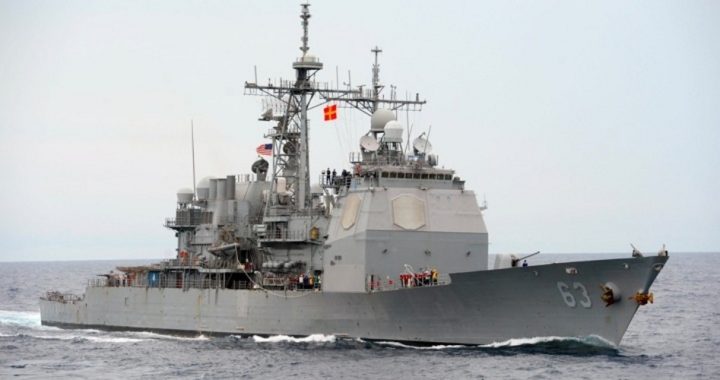
Secretary of Defense Chuck Hagel, in a statement to reporters at the Pentagon on December 19, criticized the actions of the Chinese Navy in a close encounter with a U.S. vessel in the South China Sea on December 5.
“That action by the Chinese, cutting their ship 100 yards out in front of the [USS] Cowpens [shown], was not a responsible action. It was unhelpful; it was irresponsible,” said Hagel.
Hagel seemed to switch to a vague bureaucratese when he continued: “What we don’t want is some miscalculation here to occur.” The Defense Secretary said that incidents like the one that occurred December 5 “could be a trigger or a spark that could set off some eventual miscalculation.”
VOA News on December 18 cited a statement issued by the Chinese defense ministry that confirmed a near-collision between a Chinese vessel and the USS Cowpens. According to the statement, the encounter was handled “in accordance with strict protocol” and that both sides have discussed the incident “through normal channels.”
An editorial in the Chinese state-run Xinhua news agency on December 18 stated that “fragile military links are the most vulnerable part of the two countries’ overall relationship.”
On the same day, China’s Defense Ministry seemed to downplay the incident by optimistically predicting that “China-U.S. military relations face favorable circumstances for good development.”
The United States said the Cowpens was operating in international waters when it was forced to take evasive action to avoid hitting the Chinese ship, which was traveling with China’s new (and only) aircraft carrier, the Liaoning. The Liaoning is a refurbished Ukrainian naval vessel.
During the same briefing at which Hegel spoke, Army General Martin Dempsey, chairman of the Joint Chiefs of Staff, said the Liaoning, which was commissioned last year but hasn’t begun full flight operations, doesn’t pose a threat.
The U.S. Pacific Fleet said in a December 13 statement quoted by Bloomberg News that the USS Cowpens, operating in international waters, and a Chinese naval vessel “had an encounter that required maneuvering to avoid a collision.” Army Colonel Steve Warren, a spokesman at the Pentagon, said later that the encounter wasn’t “a crisis-level incident at any stretch.”
China’s state-run Global Times newspaper citing the People’s Liberation Army Navy as its source, said the Cowpens was conducting surveillance of the Liaoning, something the Pentagon did not deny. The incident occurred in international waters, so such surveillance would not have violated China’s sovereignty.
A December 18 report in the Global Times quoted a statement from U.S. State Department deputy spokesperson Marie Harf, who said that “The US regularly conducts military operations in international waters and airspace,” adding the United States has discussed the incident “at a high level with the Chinese Government.”
The report said that a Chinese source who was familiar with this confrontation told the Global Times that the USS Cowpens was detected by the Liaoning formation “when trespassing in a no-sail zone in the South China Sea.”
The report notes that the commander of the Cowpens contacted the Liaoning formation commander Zhang Zheng by radio and that after a short communication between the two commanders, the U.S. guided missile cruiser left “the prohibited area.”
As for the legitimacy of such “no-sail zones,” a November 27, 2010 “Ground Report,” by analyst Paul Sterne notes:
China wants to create a “no-sail” zone in the China Sea. Under international law, a naval power can position its warships in international waters 22 kilometers or 14 miles or 12 nautical miles from the low tide mark of the shoreline of a foreign country. The Chinese (and many other countries) want to extend this demarcation to 200 miles or the current limit of their “exclusive economic zone.”
China, apparently, believes its unilaterally declared “no-sail zone” trumps international law.
Though reports did not pinpoint the exact locations of the incident, even Chinese sources indicate it occurred in international waters.
A New York Times’ “Sinosphere” blog noted that Retired Chinese Rear Admiral Yin Zhuo told the website of the People’s Daily, the official newspaper of the Chinese Communist Party, that the Cowpens traveled alongside the “main ships” of the aircraft carrier group, interfering with the aircraft carrier’s movements.
Admiral Yin said that both the Chinese and the American vessels were in international waters far away from China’s 12-mile territorial limit.
Yin, who is the director of the Chinese Navy Advisory Committee for acknowledged that the U.S. surveillance did not violate international law, stating: “The U.S. side did not violate international law and we did not violate international law.”
But, he warned, when a U.S. ship gets too close to a Chinese ship, “Then, sorry, we will stop you,” he said.
Yin’s admission that the United States did not violate international law did not prevent the Global Times from criticizing U.S. naval activities in the region, which are intended to secure U.S. allies such as Taiwan and the Philippines from possible Chinese military threats.
A Global Times report on December 16 stated:
If the American navy and air force always encroach near China’s doorstep, “confrontation” is bound to take place. In 2001, the collision between an American spy plane and a Chinese fighter jet was such an accident resulting from constant confrontation between the two….
We don’t think the South China Sea is a stage where the US 7th Fleet flaunts its prowess. We try to avoid friction because we wish for a new type of major power relationship with the US rather than being pressured by this fleet.
Another Global Times report on December 16 cited a statement from an unidentified Chinese source complaining that the Cowpens approached “within 45 kilometers [27 miles] of the inner defense layer of the Chinese fleet that day.”
If such figures are accurate, they confirm Admiral Yin’s assessment that neither side violated international law.
Photo of USS Cowpens: U.S. Navy



